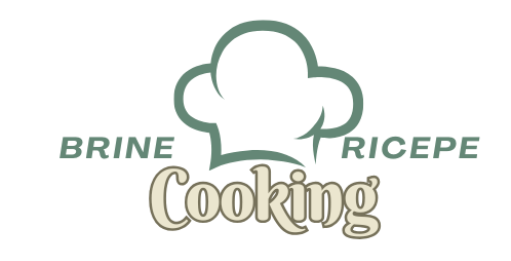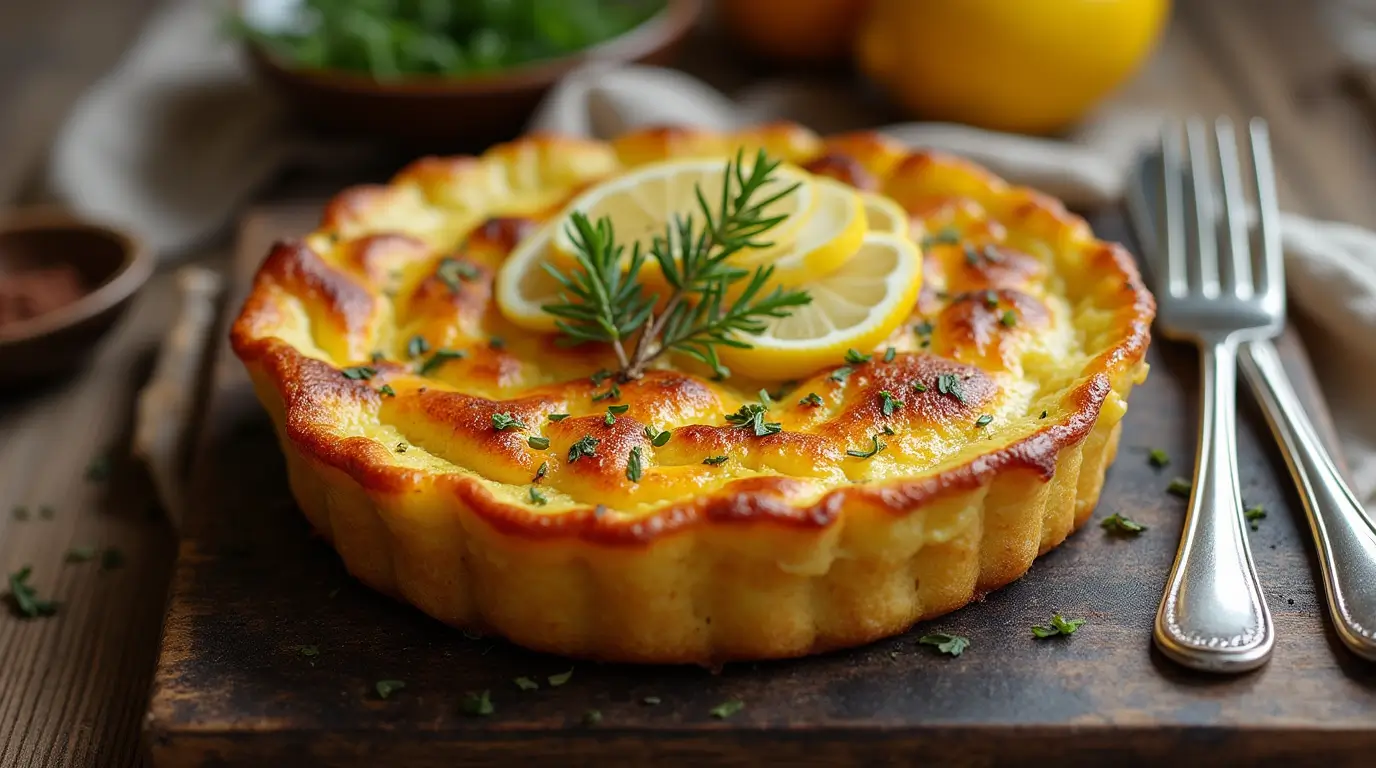Ever caught the aroma of fresh cornmeal crackling on a hot griddle, transforming into a golden disk of pure comfort? You’re about to discover the magic of hoe cakes, those deceptively simple yet soul-satisfying cornmeal delights that have graced Southern tables for generations. Whether you’re a curious food enthusiast or simply seeking to expand your culinary horizons, prepare to embark on a flavorful journey through time.
What is Hoe Cake?
Imagine a perfect marriage between a cornmeal pancake and a crispy flatbread – that’s your classic hoe cake. These delectable disks boast a wonderfully crispy exterior that gives way to a tender, slightly dense interior that’ll have you reaching for seconds before you’ve finished your first bite.
At its heart, a hoe cake celebrates simplicity. The basic recipe calls for just three ingredients: cornmeal, water, and salt. Yet somehow, this humble trio transforms into something truly extraordinary when kissed by heat and a touch of fat. The result? A versatile bread that’s equally at home soaking up breakfast egg yolks or accompanying your favorite barbecue.
Cultural Significance
You might wonder how such a straightforward dish has maintained its beloved status throughout the centuries. The answer lies not just in its taste, but in its story. Hoe cakes represent the ingenuity of Southern cooking, where necessity birthed innovation, and simple ingredients were elevated into memorable meals.
In many Southern households, you’ll still find hoe cakes served at breakfast alongside eggs and bacon, though they’re equally welcome at any meal. Their versatility extends beyond traditional servings – modern cooks often use them as a base for creative toppings or as an accompaniment to hearty stews.
The Origins of Hoe Cake: A Journey Through Time
Native American Influences
Your hoe cake’s story begins long before it earned its curious name. Native American communities had been grinding corn and preparing flatbreads for centuries before European contact. These Indigenous cooking methods laid the foundation for what would eventually become the hoe cake you know today.
The technique of grinding corn into meal and mixing it with water to create a simple bread was perfected by Native Americans, who shared their knowledge with early settlers. This exchange of culinary wisdom proved crucial for survival and eventually evolved into various cornmeal-based dishes across the American South.
How Hoe Cakes Got Their Name
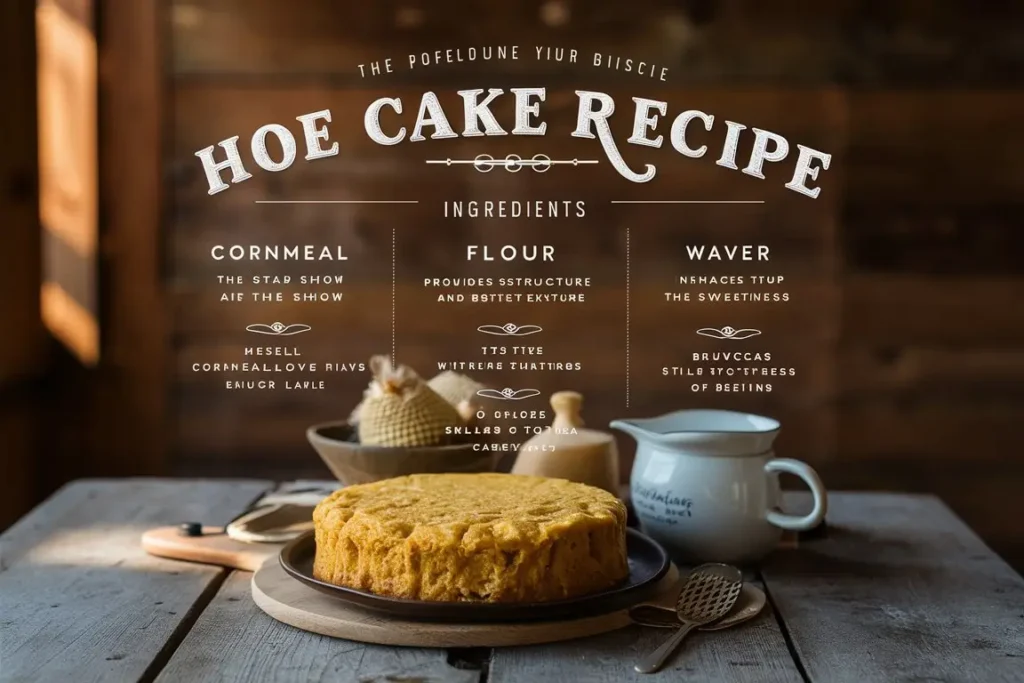
You might be wondering about that intriguing name. The story goes that field workers would cook these cornmeal cakes on their hoes over an open fire during lunch breaks. The flat surface of the hoe, when heated over flames, served as a makeshift griddle. While some historians debate this origin story, suggesting the name might come from the cake’s shape resembling a hoe blade, the tale has become an integral part of Southern food lore.
Essential Hoe Cake Recipe
Ready to try your hand at this historic dish? Here’s everything you’ll need to create authentic hoe cakes in your kitchen:
Traditional Ingredients
| Ingredient | Quantity | Notes |
|---|---|---|
| White cornmeal | 2 cups | Fine ground preferred |
| Boiling water | 1½ cups | For proper texture |
| Salt | 1 teaspoon | To taste |
| Bacon fat or oil | ¼ cup | For frying |
Step-by-Step Instructions
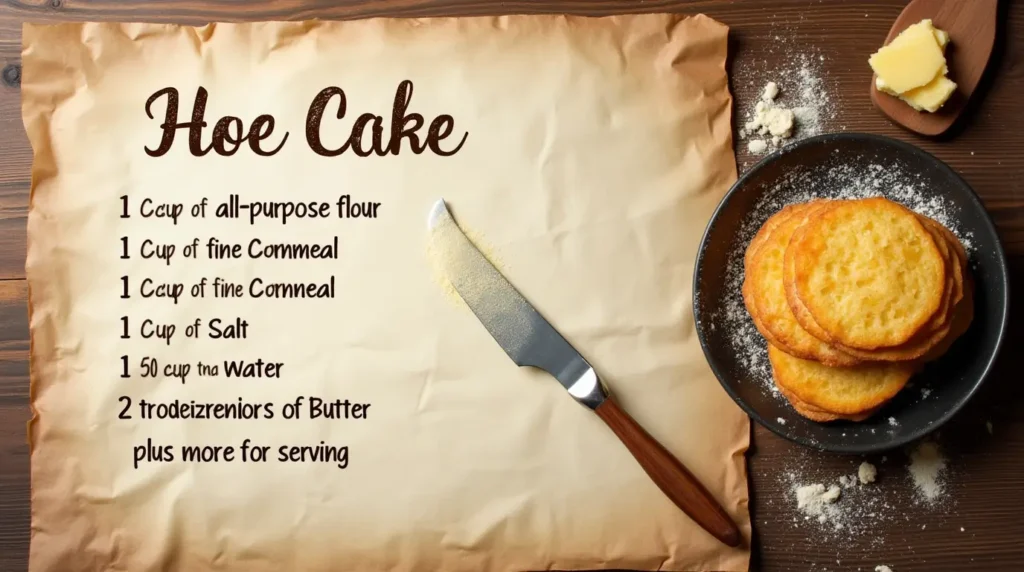
- Start by bringing your water to a boil. This crucial step helps “cook” the cornmeal slightly, resulting in a better texture.
- In a large bowl, combine your cornmeal and salt, mixing well to ensure even distribution.
- Gradually pour the boiling water into your cornmeal mixture, stirring constantly. You’re aiming for a consistency similar to thick oatmeal – not too wet, not too dry.
- Let your mixture rest for about 5 minutes. This allows the cornmeal to fully hydrate and makes for easier handling.
- Heat your skillet or griddle over medium-high heat. Add enough bacon fat or oil to coat the bottom generously.
- When the fat is shimmering hot, drop spoonfuls of your batter onto the surface, spreading them slightly with the back of your spoon.
- Cook until the edges turn golden brown and crispy (about 3-4 minutes), then flip and cook the other side until equally crispy.
Regional Variations
Your hoe cake experience might vary depending on where you find yourself in the South. Coastal Carolina cooks often prefer their cakes slightly thinner, while Georgia kitchens might serve them up a bit thicker. In the Mississippi Delta, you might encounter versions made with hot water cornbread, creating an even crispier exterior.
Hoe Cake vs. Cornbread: Understanding the Distinction
While both hoe cakes and cornbread share cornmeal as their primary ingredient, they’re distinct in several important ways. Your typical cornbread features additional ingredients like eggs, milk, and leavening agents, resulting in a cake-like texture. Hoe cakes, by contrast, remain true to their simple origins, creating a completely different eating experience.
The cooking method also sets them apart. While cornbread bakes in an oven, usually in a cast-iron skillet or cornstick mold, hoe cakes cook directly on a flat, hot surface, developing their characteristic crispy exterior through direct contact with the heat.
Modern Interpretations
Today’s culinary landscape has embraced the hoe cake’s versatility, breathing new life into this centuries-old staple. You’ll find creative interpretations that honor the original while introducing exciting new flavors and techniques.
Contemporary Variations
Your breakfast table might welcome a sweet variation, topped with maple syrup and fresh berries. Consider these modern twists:
- Honey-drizzled hoe cakes topped with whipped butter and cinnamon
- Savory versions incorporating herbs and cheese into the batter
- Gluten-free adaptations using certified gluten-free cornmeal
- Sweet potato-enriched variations adding extra nutrients and flavor
Chef-Inspired Innovations
Professional kitchens across the country have begun reimagining hoe cakes in exciting ways. You might encounter them as bases for upscale appetizers or transformed into elegant side dishes. Some notable interpretations include:
- Mini hoe cakes topped with pulled pork and coleslaw
- Crispy bases for Southern-style eggs Benedict
- Sophisticated appetizers topped with smoked salmon and crème fraîche
- Dessert variations served with bourbon-maple syrup and pecans
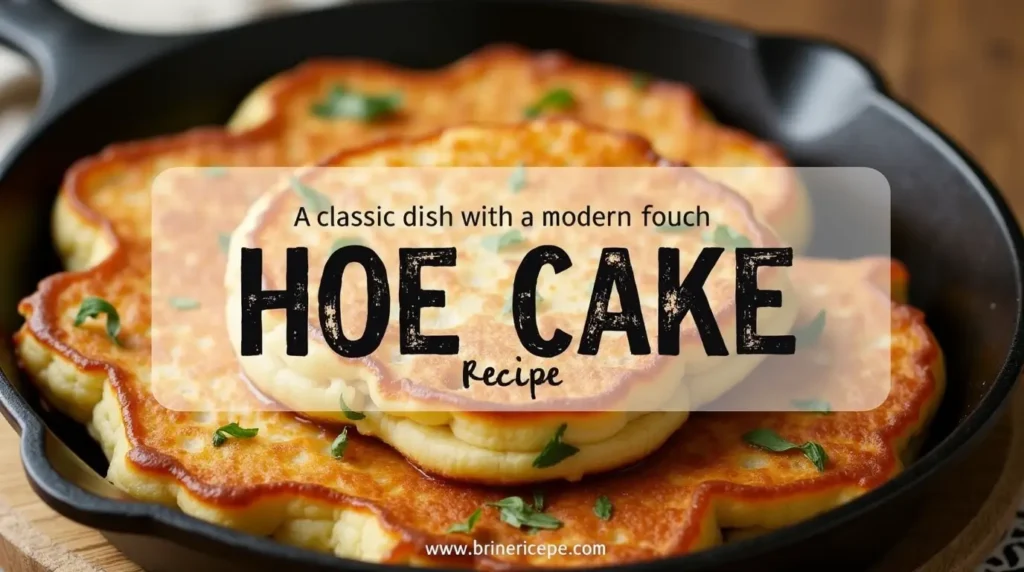
Keeping Tradition Alive
Tips for Perfect Hoe Cakes
Your success with hoe cakes depends largely on technique and attention to detail. Here’s how to achieve the perfect balance of crispy exterior and tender interior:
- Choose the right cornmeal: Look for fine-ground white cornmeal for the most traditional result. Yellow cornmeal works too, but the texture might differ slightly.
- Watch your heat: Your cooking surface should be hot enough to create that sought-after crust but not so hot that the exterior burns before the interior cooks through.
- Don’t skimp on the fat: Whether you’re using bacon grease, oil, or butter, ensure your cooking surface is well-coated. This creates that irresistible crispy exterior.
- Master the flip: Wait until you see bubbles forming and the edges turning golden before attempting to flip your hoe cake. Patience yields better results.
Frequently Asked Questions
What makes a hoe cake different from a pancake?
While both are cooked on a flat surface, hoe cakes rely solely on cornmeal rather than wheat flour, creating a distinctively crispy texture and corn-forward flavor that sets them apart from traditional pancakes.
Can I make hoe cakes ahead of time?
While they’re best served fresh off the griddle, you can prepare them in advance and reheat them in a hot skillet to restore some of their signature crispiness. Avoid microwave reheating, as this can make them tough.
What’s the best way to store leftover hoe cakes?
Store any leftovers in an airtight container at room temperature for up to two days. When ready to enjoy, reheat them in a skillet with a touch of butter or oil to revive their crispy exterior.
Are hoe cakes gluten-free?
Traditional hoe cakes made with just cornmeal, water, and salt are naturally gluten-free. However, always verify that your cornmeal is certified gluten-free if you’re preparing them for someone with celiac disease or gluten sensitivity.
Can I use regular cornmeal instead of white cornmeal?
Absolutely! While white cornmeal is traditional in many regions, yellow cornmeal works perfectly well. The main difference will be in color and a slightly more pronounced corn flavor with yellow cornmeal.
Conclusion
Your journey through the world of hoe cakes reveals more than just a recipe – it’s a window into American culinary history, showcasing how simple ingredients and necessity can create enduring traditions. Whether you’re drawn to their historical significance or simply love their crispy, cornmeal goodness, hoe cakes offer a unique taste of Southern heritage that’s as relevant today as it was centuries ago.
Ready to start your own hoe cake tradition? Head to your kitchen with these tips and techniques in hand, and soon you’ll be pulling golden, crispy cakes off the griddle that would make any Southern grandmother proud. Remember, the beauty of hoe cakes lies in their simplicity – embrace the basic technique, then let your creativity guide any variations.
Share your hoe cake adventures in the comments below, and don’t forget to subscribe to our newsletter for more Southern cooking traditions and modern interpretations. Your kitchen is about to become home to a piece of living history!
